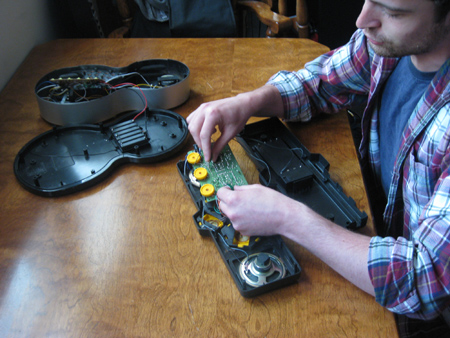 Warm weather most assuredly brings to attention at least two things around here: allergies and yard sales. Local residents start selling off their old junk, while other folks see the trash as more of a treasure, taking discarded junk and repurposing it.
Warm weather most assuredly brings to attention at least two things around here: allergies and yard sales. Local residents start selling off their old junk, while other folks see the trash as more of a treasure, taking discarded junk and repurposing it.
There exists a group of people who crave the whining sound of a discarded whizbang, the digital bleep of a banished keyboard and the crackling fuzz of a short-circuited Furby. The most rewarding part is that they created the sounds themselves using a technique called circuit bending.
Circuit bending is the art of intentionally rewiring electronic toys or instruments to produce sounds or images the maker didn’t intend for the objects to make. Yard sales provide a perfect place to find that bendable plaything for a penny or so.
The process involves cracking the toy open and bridging different points on the circuit board with a test wire or even just your fingers. All you really need is wire and a soldering iron to solder the two points together. The result could be an extremely abnormal sound coming from the toy you’re playing with.
The “father” of circuit bending and the man associated with coining the term is Reed Ghazala, who has been circuit bending for more than 45 years. His bent works of art have been featured in everything from Rolling Stones’ songs to the Museum of Modern Art in New York City. The Cincinnati, Ohio, resident witnessed a spike in the interest of manipulating circuits when the Speak and Spell was introduced in 1978.
The Speak and Spell, a simple electronic toy used to teach children how to read and spell, ignited a fiery passion for the art because it was the first toy to emit a synthetic voice emulator. Curiosity ensued.
Benders slowly began to pop up, much like the flowers seen sprouting around this season. The Speak and Spell planted the seed, and the curiosity of this new art form seemed to pollinate the entire country.
Since then, circuit bending has become increasingly popular, even garnering its own festival each year. Bent Fest is held every year around the month of April, right in time for everyone else’s spring cleaning fever. This year it was held in Brooklyn, New York, the weekend of April 22-24, giving novice benders about a year to perfect their creations for next year’s event. But what makes circuit bending so fun?
“It can entertain and, at least in my opinion, keep me amazed in a way that traditional instruments don’t,” says Ghazala.
You never know what sound is going to be emitted from the device, creating an exciting activity for both children and adults.
“I used to bend with my dad way back,” Nashville resident Austin Brown remembers. He sits behind a neon green spray-painted keyboard, his long brown hair draped over the keys as he makes the keyboard squeal releasing otherworldly sounds. “It was a perfect way to spend a rainy day, making all sorts of weird noises, and it was cheap fun too because all the toys cost like a buck or two.”
Of course, if you’re messing around with electronic devices, there are dangers in circuit bending.
“I wouldn’t bend anything that’s plugged into the wall. You’re askin’ for trouble if you go there,” Brown warns.
So unless you want a permanent flattop hairdo or want to look like something out of Saturday morning cartoons, stick with battery-powered electronics.
If you’re unsure about the whole process or want to do more research before you get your children involved, there are several how-to videos that can be found on YouTube, and plenty of information elsewhere on the Internet.
The weekends are sacred sleep-in days for most students, but if you can muster up enough energy to get out to a yard sale, you might find yourself knee deep in a new and exciting hobby. There isn’t a need for electronic expertise, just a little curiosity, patience and imagination.













